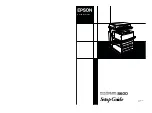
2. Turning ON/OFF the Static Eliminator Bias/Fixing Bias
The DC controller generates the static eliminator/fixing roller bias ON command
(SFON*) to turn on and off the static eliminator bias and the fixing roller bias.
• When the static eliminator bias/fixing roller bias is on,
SFON*=0
→
The remote circuit turns on.
→
The AC drive circuit turns on.
→
The high-voltage transformer turns on. (static eliminator bias/fixing
roller bias output)
When the high-voltage transformer turns on, a voltage of about 3.0 kV is applied to
the static eliminator and a voltage of about 740 V is applied to the upper fixing roller.
• When the static eliminator bias/fixing roller bias is OFF,
SFON*=1
→
The remote circuit turns off.
→
The AC drive circuit turns off.
→
The high-voltage transformer turns off.
Reference:
The copier uses a conductive upper fixing roller so that residual charges on copy
paper flow through the roller when the paper moves through the fixing assembly,
causing toner to spread over the image if not remedied.
To prevent such a problem, a positive bias is applied to the fixing roller during
copying operation.
3. Switching the Output of the Static Eliminating Bias
Copy paper comes to possess high resistance once it has moved through the fixing
assembly. In automatic two-sided mode, therefore, the DC controller PCB generates the
static eliminator voltage level switch command (SPCH) to turn on the high-voltage
transformer, thereby applying static eliminator bias (about 4.0 kV) to the static eliminator.
4. Preventing Separation Faults (thin paper picked up from the multifeeder)
If separation faults occur when copying on thin paper picked up from the multifeeder,
the voltage applied to the static eliminator may be kept at about 4.0 kV at all times so as
to facilitate separation of paper from the drum. (Use ‘510’ in service mode; for details,
see Chapter 11 “Service Mode.”)
4-10
CHAPTER 4 IMAGE FORMATION SYSTEM
COPYRIGHT © 1997 CANON INC. CANON NP6330 REV.0 MAY 1997 PRINTED IN JAPAN (IMPRIME AU JAPON)
Conditions:
1st side of one-sided/automatic two-sided copy
2nd side of automatic two-sided copy
application voltage
about 3.0 kV
about 4.0 kV








































